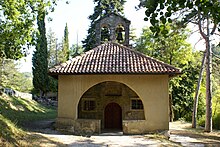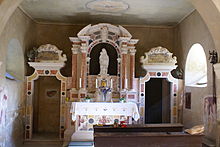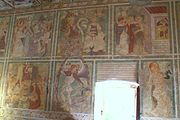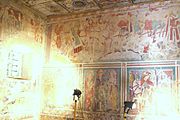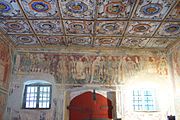Mary in the rock
The pilgrimage church of Mary on the Rock or St. Mary on the Stone Tablets ( Sveta Marija na Škriljinah ) is a 13th-century building near the Croatian town of Beram . His 46 Gothic frescoes from 1474 by Vincent from Kastav are significant in terms of art history .
The church is located about a kilometer northeast of Beram in the local cemetery. It is named after the rock layers on which it was built. The roof was also covered with stone slabs until it was rebuilt.
history
Around the year 1000 there was a Benedictine abbey at this location . There is no historical record of when the monastery was abandoned. It is believed to have been abandoned between the 12th and 13th centuries when the Benedictines largely disappeared from this area. The church Maria im Fels was built in the 13th century. In 1474 Vincent from Kastav painted the frescoes on the inner walls of the building. During construction work in the 18th century, the church received, among other things, the portico. Some of the paintings on the west wall were removed or damaged because openings were made for new windows. The ribbed vault in the chancel was also removed. During this time, the flat coffered ceiling was also attached (1707) and thus the view of the roof structure was blocked and a painted wooden tab was inserted over the nave . In the middle of the coffered ceiling is the Assumption of the Virgin Mary . The frescoes on the walls were covered with plaster over time. They were uncovered again in 1913. Compared to frescoes in other medieval churches, which were covered with plaster in the Baroque or later, this is an early point in time, as many such paintings were only uncovered after the Second World War .
Architecture and interior design
The church has a presbytery the width of the nave, a portico ( lopica ) with three arches and a bell tower with a double-arched window ( biforic window ) and a bell. It has an elongated floor plan with a rectangular nave. The main entrance on the west side is closed by a red door; it has a semicircular end. The side entrance is formed by vertically placed monoliths in the plane of the wall and horizontally placed stones above. Both are characteristics of the Romanesque . To the right of it, a holy water font is embedded in the outer wall, which was made from a piece of limestone . Above the main entrance there is a semicircular niche with the remains of an image of Mary . In addition to the round windows on the walls of the apse, two small windows are let into the sides ; further windows are in the west wall to the left and right of the main door.
The interior is divided by a round arch that separates the presbytery, in which there is a small altar , from the nave . The floor is covered with rectangular slabs of limestone . Behind the church are the graves of the cemetery, which is surrounded by a high limestone wall.
Frescoes
Today the church is primarily known for its 46 Gothic frescoes , including the dance of death, which is extremely rare to find south of the Alps . They comprise 38 figure compositions and eight small pictures, including three plant ornaments, coats of arms , the veil of Veronica , an inscription and fragments and cover almost the entire wall surface of the nave of the church and small areas of the choir, whose walls were originally, with an area of around 75 square meters were also fully painted.
The murals are among the most important paintings of medieval art in Istria and are considered one of the most famous cultural monuments of the county . They have been covered in numerous specialist publications, first by France Stelè in 1923. The frescoes are particularly unusual because of their particularly close proximity to life and the strong expression of Gothic idealism .
According to an inscription above the southern side door, the frescoes were painted in 1474 by Vincent de Kastav (Italian Vincezo da Castua, German Vincent from Kastav). He is probably the father of Ivan de Kastav (Italian Giovanni da Castua, German Johannes von Kastav), who designed the Trinity Church in Hrastovlje , Slovenia, in 1490 .
subjects
On the south and north walls of the church there is a cycle of frescoes with scenes from the life of Mary and Jesus Christ , combined with interspersed depictions of various saints and figures from the Old Testament. The west wall is decorated with symbolic - allegorical frescoes on the subject of death. The frescoes are arranged in two rows one above the other on all three walls.
South side
The cycle begins in the nave at the front right on the south wall. In the top row we see from left to right: the birth of the Virgin , the passage to the Temple ( Mary is consecrated in the temple ), the engagement of the Virgin , the Annunciation , the Visitation of the Virgin Mary , the birth of Christ with the Annunciation to the shepherds at the top right and the offering of Jesus in the temple ( Jesus is consecrated in the temple ). In the bottom row set from right to left Massacre of the Innocents , Flight into Egypt , the Saint Sebastian , the Archangel Michael as a weigher of souls , the twelve year old Jesus in the Temple , Jesus' baptism in the Jordan River , and the St. Florian and St. John (Evangelist ) . In the window reveal King David and a prophet are depicted at the top, and Saints Ursula and Catherine at the bottom . The chronological order is not entirely correct, because the flight to Egypt should be ordered before the child murder.
North side
On the north wall, the scenes in the upper row are not continued chronologically. From left to right there are only two images, as the first one extends over a length of eight meters and thus takes up a width of six fields. It is the adoration of the kings that should follow the image of the birth of Christ. The next scene is The Last Supper , which would actually have its place after Jesus entered Jerusalem. In the foreground of this fresco is shown how Christ washes the feet of his disciples . The bottom row shows again a correct chronology of Jesus' life, from left to right are shown: Jesus' temptation in the desert , the holy Apollonia , the holy Leonhard , the St. Barbara , St. Martin , St. Georg , Jesus' entry into Jerusalem , Prayer on the Mount of Olives and the imprisonment of Jesus , during which it is also shown how Peter chops off Malchus' ear with a sword . In the reveal of the window we find the four Latin Fathers of the Church , above left Gregory the Great , opposite him Jerome , below on the left Augustine and on the right Ambrose .
The life of Jesus originally continued with his suffering and triumph on the walls of the apse . What remains are Saint Stephen and the prophets Moses , Elijah and Daniel on the north side of the apse and two saints on the south side. In the vault there were probably the symbols of the four evangelists and angels.
West side
On the west wall, the finiteness of human life is represented in an allegorical way. In the lower row, south of the entrance, is the fall of man , north of the wheel of life . Both frescoes are more than half destroyed by the installation of windows. Above this, the dance of death extends over the entire width of the wall, which is seven meters . It shows death in the form of skeletons that individuals from all classes carry with them, from left to right a merchant , a knight , a cripple , a child, a landlord, a queen, a king , a bishop , a cardinal and a Pope . The merchant points in vain to the table on which lies the money with which he wants to buy his way out. The farmer is missing as the main visitor to the church, who was probably left out out of superstition . One of the skeletons plays a stringed instrument , similar to a mandolin , and several others play wind instruments ; one carries a bow and arrow , another a scythe . On the far right, too, is Death , playing a bagpipe , over an open grave . The artist wanted to show that all people, regardless of their status , are on an equal footing before death.
Representation
The frescoes in the Church of Maria im Fels are characterized by their simplicity and naivety , creating a connection between the popular painting tradition and the international art of the late Gothic period. In addition, several styles and motif templates are combined in one cycle.
Influences
The frescoes in Beram were created by at least two artists, which can be recognized by different stylistic features. These differences can, however, also arise from the different templates that were used in the work (see below). In addition, the works could have been changed during the restoration work. It is likely that Vincent created the frescoes on the south side.
There is evidence that the artist of the dance of death and the Judas kiss used models from the Dutch painter, known as the master with the banners ; works by master ES were used as models for the birth scene . Signs of this can also be seen in the pictures, such as the hard folds of the robes or mistakes in drawing.
Although the author comes from Kastav, the frescoes in Beram have a Friulian character. They are influenced by German-Tyrolean-Carinthian painting. Northern influences can be recognized, among other things, by the folds of Mary's robe. Italian features are the depiction of the robes of some nobles, long parallel folds of some draperies and the motif of the cavalcade , which is particularly common in the Italian Quattrocento .
Style features
Different styles can also be recognized in the representations: idealism , which is contained in the motif of the Madonna, among other things, late Gothic naturalism , which is shown, for example, in the bloody sweat of Christ in the scene of prayer on the Mount of Olives or in the murder of innocent children, and Renaissance - Realism that can be seen in parts of the Marian cycle, especially in the scene Escape to Egypt , and the procession of the dead. In addition, there are approaches to perspective such as the depiction of the plaster in the scene of St. Martin.
The method of anachronism can be found in almost all the pictures in the fresco cycle . The depicted scenes from the life of Mary and Christ take place in the 1st century AD. Nevertheless, except for Christ and the apostles , who are dressed in antiquity , all other people wear contemporary clothing from the late Gothic or Renaissance periods , as is customary in Christian art . There are also medieval knights and architecture .
There is hardly any depth of space in the paintings . With the exception of the scene of St. Martin, the action takes place in a very narrow area, as is the case with the frescoes in St. Martin's Church. In the scene Escape to Egypt , which is one of the calmest and most realistic depictions, the impression is created by three levels - in the foreground the meadow with the two pigs, behind it the main level with Mary and her companions and in the background the landscape with two small towns generated by depth, which however does not fully succeed. However, a reference to spatiality is created by the apparent narrowness in the pictures, in which, for example, legs, headgear, instruments or objects protrude from the frame. In some scenes there are figures in the foreground within the frame, while buildings in the background protrude beyond it. The proportional reduction in size with distant figures can also be determined. The piercing of the frame can be seen especially in the Judas kiss scene . This gives the representation a satirical character. The farmhand at the bottom of the picture arouses the pity of the viewer on the one hand, but at the same time looks a bit ridiculous. It is this fact that makes the subject appear even more alive. There is also a contrast between the ceremonial kiss and the soldiers in the background. In some of the pictures there are representations of processes taking place one after the other, in which persons acting can also appear several times (temporal or spatial simultaneity).
The paintings are very colorful and many have simple ornaments . These include, for example, stars in the daytime sky or decorations on clothing that have been made with the help of prefabricated templates or stamps .
On the one hand, the Adoration of the Magi scene is emphasized by its size; on the other hand, the life-affirming painting contrasts with the fresco of the dance of death on the neighboring wall to the left, which also extends over several fields (about three). The colored robes of the riders with colorful hats and flags on white horses in a blooming landscape contrast with the gloomy hues of the funeral procession. In addition, there are hunting motifs and illustrations of various animal fables ( the fox and the rooster , the fox and the stork ) incorporated into the image of the cavalcade .
literature
- Dario Alberi: Vermo - Beram. In: Istria. Storia, arte, cultura . Lint, Triest 1997, pp. 1453-1461. ( PDF; 117 kB , source for information without individual references)
- Radovan Ivančević: Beram . Translated from Serbo-Croatian by Zora Keran. Jugoslavija Publishing House, Belgrade 1965.
- Jože Kastelic: Beram. The frescoes of Istria . Jugoslavija, Belgrade 1955. (French Beram. Les fresques d'Istre , English Beram. Istrian frescoes )
Web links
Individual evidence
- ↑ a b Beram - Vermo. Churches and Cemeteries. Cemetery and Sanctuary of St. Mary of Beram (Vermo) at istrianet.org
- ↑ a b c Beram travel guide ( Memento of the original from April 6, 2008 in the Internet Archive ) Info: The archive link has been inserted automatically and has not yet been checked. Please check the original and archive link according to the instructions and then remove this notice.
- ↑ a b Radovan Ivančević: Beram . Jugoslavija Publishing House, Belgrade 1965. Translation from Serbo-Croatian by Zora Keran. P. 7
- ↑ a b c d e f g Radovan Ivančević: Beram . Jugoslavija Publishing House, Belgrade 1965. Translation from Serbo-Croatian by Zora Keran. P. 8
- ↑ a b c Antun Travirka: Istria. History. Culture. Artistic heritage . Forum, Zadar 2006, ISBN 953-179-468-5 . P. 57
- ↑ a b The medieval frescoes of Beram ( Memento of the original from March 5, 2007 in the Internet Archive ) Info: The archive link was inserted automatically and has not yet been checked. Please check the original and archive link according to the instructions and then remove this notice.
- ↑ a b Radovan Ivančević: Beram . Jugoslavija Publishing House, Belgrade 1965. Translation from Serbo-Croatian by Zora Keran. P. 5
- ^ Radovan Ivančević: Beram . Jugoslavija Publishing House, Belgrade 1965. Translation from Serbo-Croatian by Zora Keran. P. 7 f.
- ^ Dietrich Höllhuber: Croatia . DuMont Reiseverlag, 2006, ISBN 3-7701-7609-X . P. 194 ( Scan on Google Book Search)
- ^ Dietrich Höllhuber: Croatia . DuMont Reiseverlag, 2006, ISBN 3-7701-7609-X . P. 193 ( Scan on Google Book Search)
- ↑ Egmont Strigl: Discover Istria: On the way between Poreč, Pula and Opatija . Trescher Verlag, 2004, ISBN 3-89794-048-5 . P. 230 ( Scan on Google Book Search)
- ↑ Turistička zajednica Grada Pazina ( Memento of the original from February 11, 2009 in the Internet Archive ) Info: The archive link was automatically inserted and not yet checked. Please check the original and archive link according to the instructions and then remove this notice.
- ↑ Beram - Vermo. Cities, Towns and Hamlets at istrianet.org
- ↑ a b c Jože Kastelic: Beram. Les fresques d'Istre . Jugoslavija, Belgrade 1955. p. 9.
- ↑ a b Darja Peitz Hlebec: ADAC travel guide plus. Istria and Kvarner Golf. With vacation card . ADAC Verlag, 2006, ISBN 978-3-89905-295-4 . P. 42
- ↑ a b Radovan Ivančević: Beram . Jugoslavija Publishing House, Belgrade 1965. Translation from Serbo-Croatian by Zora Keran. P. 9
- ↑ a b c Radovan Ivančević: Beram . Jugoslavija Publishing House, Belgrade 1965. Translation from Serbo-Croatian by Zora Keran. P. 67
- ↑ a b c d e f Radovan Ivančević: Beram . Jugoslavija Publishing House, Belgrade 1965. Translation from Serbo-Croatian by Zora Keran. P. 10
- ↑ Vermo - Beram. Note di storia. ( Memento of the original from May 12, 2006 in the Internet Archive ) Info: The archive link was automatically inserted and not yet checked. Please check the original and archive link according to the instructions and then remove this notice. (PDF; 117 kB, Italian)
- ↑ a b Radovan Ivančević: Beram . Jugoslavija Publishing House, Belgrade 1965. Translation from Serbo-Croatian by Zora Keran. P. 13
- ↑ a b Radovan Ivančević: Beram . Jugoslavija Publishing House, Belgrade 1965. Translation from Serbo-Croatian by Zora Keran. P. 11
- ^ Jože Kastelic: Beram. Les fresques d'Istre . Jugoslavija, Belgrade 1955. p. 12.
- ↑ a b c Radovan Ivančević: Beram . Jugoslavija Publishing House, Belgrade 1965. Translation from Serbo-Croatian by Zora Keran. P. 12
Coordinates: 45 ° 15 ′ 24 ″ N , 13 ° 54 ′ 26 ″ E
